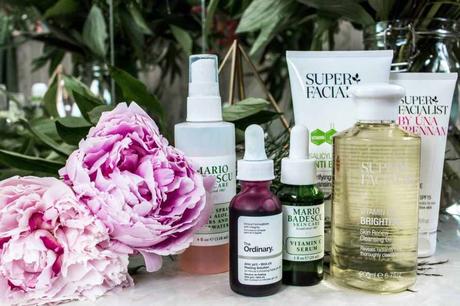
Besides age and ethnicity, it's clear that skin doesn't share similar characteristics.
Generally, our skin is characterized by its skin type, which is determined by several factors. These factors include age, genetics, and environment.
Your skin type influences the skin ability to retain water, produce sebum, its sensitivity as well as a propensity towards skin conditions like acne. Skin types include:
How to Tell Your Skin Type

You are lucky if you have a normal skin! Also known as eudermic skin, normal skin type is described as well-balanced skin.
Factors that affect the health of your skin, particularly sebum production, moisture content, sensitivity, and propensity to skin conditions usually are within a normal range.
Normal skin appears healthy, clear, and radiant. Most younger people have a normal skin type.
Characteristics of a normal skin type- The skin is neither too dry or too oily.
- The skin tone is smooth, even and clear.
- The skin has a radiant complexion.
- It's hardy against irritants and elements.
- The skin is free of blemishes, and the pores are hardly visible.
This is the most common type of skin, and it's normally characterized by a combination of dry skin and oily skin in different areas of the face.
People with this skin type usually have oily skin in their T-zone area. This means that they have sebum overproduction around their forehead, nose, and chin.
While they lack sebum production around the mouth, cheeks, and eyes, therefore, experiencing dry skin in these regions.
Characteristics of a combination skin type- Normal or dry skin around eyes, cheeks, and mouth.
- Acne-prone, especially on the forehead, nose, and chin.
- Oily skin and enlarged pores around the forehead, nose, and chin.
? Check out the best skincare products for combination skin right way
>>> Read More:Cleanser - 11 Best facial cleanser for combination skin
Toner - 20 Best Toner for Combination Skin
Moisturizer - 10 best Moisturizer for Combination Skin
Primer - 10 Best Primers For Combination Skin
This skin type is generally caused by overactive sebaceous glands which produce so much sebum a condition known as seborrhea. Oily skin is majorly influenced by genetics.
However, factors such as diet, certain medication, stress, choice of skincare products, and hormonal changes also can cause oily skin.
Individuals with oily skin type are more prone to skin issues such as acne as well as skin blemishes. More men than women, particularly during adolescent and young adulthood, have oily skin type.
Characteristics of oily skin- Skin typically appears greasy and shiny.
- The skin looks paler and thicker with enlarged and visible pores
- Oily skin looks less aged and plumper; however, it's prone to acne in the T-zone area.
? Check out the best skincare products for oily skin right way
>>> Read More:Cleanser - 10 Best Face Wash For Oily Skin
Moisturizer - Characteristics of Acneic skin 10 Best Moisturizers for Oily Skin
Foundation - 10 Best Liquid Foundations for Oily Skin
Acne is a common skin condition and generally occurs during puberty but might also occur at any age. There is no real danger of having acneic skin, however, it leaves scars on the skin.
Characteristics of dry skinAlthough having acne is a totally regular occurrence, genetics, certain medicines, hormone fluctuation, and manipulation of acne lesions aggravate the condition.
- Blackheads, whiteheads, post-inflammatory hyperpigmentation, breakouts, and blemishes.
- Pimples frequently appear on the face neck, chest, back and shoulders.
? Check out the best skincare products for acneic skin right way
Also known as xerosis, dry skin is a common skin complaint. Environmental factors and genetics are the main causes of dry skin.
Individuals with dry skin often lack natural moisturizing factors that affect skin water retention and produce less sebum as compared to other skin types. Women are more prone to dry skin. Skin gets dryer as we age.
Characteristics of sensitive skin- Skin texture feels typically rough, and the pores are barely visible.
- Enhance wrinkles and fine lines.
- Blotchy and dull complexion.
- The skin is prone to infection, redness, and irritation.
- Itchiness, scaling, flaking, cracking, and chapping may occur.
? Check out the best skincare products for dry skin right way
Sensitive skin usually is easily irritated by factors that are easily tolerated by people with other skin types.
For some, sensitive skin is permanent, but for others, it's triggered by either internal or external factors such as skincare products or environmental factors. When your skin's natural barrier function is compromised, leading to water loss and allowing the penetration of irritants sensitive skin occurs.
When the facial skin is exposed to the sun, ingredients, harsh products or weather conditions, sensitive skin can cause stinging, blotchy patches and/or rashes.
- Your skin can become flushed red easily from sun exposure, wind, or cleansing.
- The skin itches, stings, burns and sometimes becomes excessively dry, swollen or flaky.
- The skin easily breaks out and develop red spots and rashes.
? Check out the best skincare products for sensitive skin right way

Still Not Sure What Skin Type You Have - Skin Type Test
The most essential step when it comes to skincare is understanding your exact skin type and how it adapts to seasonality or other circumstances.
Taking time to learn and understand the specific needs of your skin is vital in choosing the right options when it comes to skincare products that will balance your skin. Consequently, resulting in a radiant and a healthier complexion.
Before purchasing moisturizers, foundation, or cleansers when it comes to properly taking care of your skin, it's essential to get to know your skin type. Here is an easy guide to help determine your skin type at home.
How to do:Test 1: the bare-faced method
- Use a mild cleanser to thoroughly wash your face then pat it dry. Don't apply any product on your face; leave it bare for about 30 minutes.
- Examine your forehead, nose, cheeks, and chin for any shine after the 30 minutes have elapsed.
- Wait another 30 minutes then evaluate whether your skin feels dry or patched when you smile or make other facial expressions.
Results:
You are likely to a have a dry skin type if your skin feels tight.
Your skin is most likely combination/normal skin type if there is any noticeable shine on your forehead or nose.
Your skin type is likely to be oily skin if you have additional noticeable shine on your forehead, nose and cheeks.
Test 2: The blotting sheet method
This test is a faster and better way to differentiate between dry and oily skin types.
- Gently pat different parts of your face using a blotting paper.
- Hold up the sheet to the light and examine how much oil can be visible.
Results:
You most likely to have dry skin if the blotting paper picked no oil.
Your skin type is combination/normal skin if the blotting paper picked up oil from the nose and forehead areas and your skin type is likely to be oily skin if the sheet is saturated with oil.

